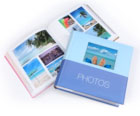What Was Old Is New: How the Photocopier Evolved into the Laser Printer
From the 1950’s through the 1980’s, photocopiers created a copy of text or an image by reflecting light off of the white areas of the original (which had been laid face down on the glass platen) onto a charged drum. This reflected light neutralized the charge on the drum so that when oppositely charged toner was applied to the unexposed (and still charged) areas of the drum it would stick. The toner was then transferred from the drum to the paper and fused by heat and pressure to create the final copy. Laser printing is an updated version of this process. Now the original document or image is scanned and an electronic file is created. The data in this file is then used to control a laser which exposes the charged drum. From there, the rest of the process is the same with the toner being transferred to the paper and then fused to make it permanent. The process, whether to make direct photocopies from originals or laser prints, is technically known as electrophotography.
Read More

Revision of ISO 18920 Imaging Materials – Reflection Prints – Storage Practices
The International Organization for Standardization (ISO) has recently published a revised version of their storage standard for reflection prints. The standard’s scope includes both traditionally printed photographic images as well as modern digitally printed images. It does not include recommendations for documents printed with digital output systems (see ISO 1799 Information and documentation -- Document storage requirements for archive and library materials). The original ISO 18920 standard was published in 2000. The previous recommendations for long-term storage of reflection prints lumped all digital processes into a single category, “All other”, and put the maximum allowable storage temperature for these materials at -3° C and the relative humidity range at 30-50% RH.
Read More

Frequently Asked Question
We are often asked whether we have tested any of the various post-printing treatments used on digital hardcopy. These can include sprays, laminates, as well various mounting systems. IPI is not currently studying the impact these treatments may have on digital prints over the long-term. There are two reasons for this. The first is that the number of print variations (printing technology, colorants, and paper types), without adding the complexity of treatment variations, is already very large. The second is that there are no existing test methods by which to evaluate the performance of the treated prints. For now, we believe our best approach will be to thoroughly understand the print materials’ behavior without treatments. From that point, new test methods may be developed to begin to understand how post-print treatments will affect the preservation of the printed materials.

Terminology: Photobook
 Photobook – a photobook differs from a photo album in that the images are printed directly on the page as opposed to being glued onto (as in a scrapbook or magnetic album) or slid into the page (as in a pocket page or flip type album). These, more closely resemble coffee table books than scrapbooks. They are a product of the age of digital photography and printing. Photobook – a photobook differs from a photo album in that the images are printed directly on the page as opposed to being glued onto (as in a scrapbook or magnetic album) or slid into the page (as in a pocket page or flip type album). These, more closely resemble coffee table books than scrapbooks. They are a product of the age of digital photography and printing.
|